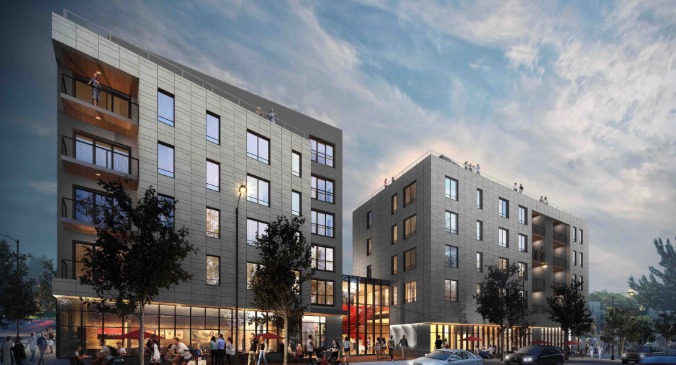
The company that traditionally has grown through acquisition, but bought no assets at all in the first three quarters of 2009, bought two in Q4. Last October, the REIT closed an all-cash transaction to purchase the 326-unit Metropolitan at Pentagon Row in Arlington, Va., from a joint venture of Cornerstone Real Estate Advisers and Kettler, beating out around 40 bidders for the six-year-old, 15-story high-rise that sold for a price Equity Residential’s CEO David Neithercut said, at the end of October, represented a 30 percent discount to what the property would have traded for several years ago. The second was the one-year-old, 242-unit Mosaic at Largo Station near FedEx field in Maryland that was in lease-up when the deal closed. The aggregate purchase price for the two assets came to $145 million at a cap rate of 5.9 percent.
At the end of January, Equity Residential bought another 220 units in Metro D.C. from Silver Spring, Md.-based Sunburst Hospitality in a high-rise apartment tower that is the rental portion of Sunburst’s Vista on Courthouse luxury residential community in Arlington. The ritzy enclave that also includes for-sale town homes and duplexes is within walking distance of the Court House Metro and a number of retail, dining, entertainment and transportation options in Clarendon and along the Rosslyn-Ballston corridor.
But this year, it’s the large, complex, off-market deals that are the REIT’s targets for acquisition this year and its New York City buys have grabbed the headlines. At the end of January, Equity Residential bought two assets in Midtown Manhattan from Macklowe Properties and a third that closed at the end of March, for a total of $475 million.
The REIT that was founded by real estate legend and Chairman Sam Zell in 1967 and became a public company in 1993 entered Manhattan in the middle of 2004 with the $93.1 million purchase of the 259-unit Hudson Crossing from Dermot Co., just prior to the REIT’s $809 million acquisition of Trump Place—three high-rise apartment towers that house 1,325 apartments on the Upper West Side of Manhattan. The sales tag for those three towers represented a per-unit cost of $580,000, or $723 per sq. ft., which then-CEO Bruce Duncan, who turned that position over to Neithercut in January 2005, said at the time was a good deal in a market where comparable assets were selling for $900 to $1,000 per sq. ft.
How times have changed
The three Macklowe properties that include 910 apartments, 23,339 sq. ft. of retail space and 50,000 sq. ft. of parking sold for a price that equates to about $470,000 per apartment, or about $545 per sq. ft., a clear reflection of the dismal economy that has forced New York City veteran real estate tycoon Harry Macklowe, who founded Macklowe Properties in the mid-1960s to exit the residential sector in order to pay his bills. Macklowe has been hurting for cash since he came up short on repayment of debt he incurred when he bought seven office buildings in Manhattan at the top of the market in 2008 from Blackstone Group LP—the same buildings Blackstone bought from Zell when Equity Residential’s chairman sold Equity Office Properties to the investment manager and financial advisor.
According to apartment market-watchers in the Big Apple, William Macklowe, whose father handed him the reins to the company in 2008, contacted Zell in early December to discuss a possible deal for the properties that would provide the Macklowe family with funds to pay off pressing debt. Equity Residential was in the Macklowe offices the very next day.
The REIT has grown its Gotham portfolio slowly in similar size chunks over the past six years, rather than one-offs, which Neithercut expects is an acquisition strategy the company will stick with throughout this year, now that the six- or seven-year-long repositioning of the real estate giant is complete. CFO Mark Parrell said, during a panel discussion at the Oppenheimer Real Estate Outlook Forum in mid-January, the company was sort of the mutual fund of apartments five years ago, when the REIT was operating in 40-some markets with a portfolio preponderance of garden product.
The Equity Residential of today is a vastly different company than it was back then, both geographically and relative to asset type, operating in just 20 high-barrier-to-entry markets with the majority on the East and West Coasts, with a greater diversity of product type, from the traditional garden-style to the ritzy high-rise in New York City.
“It’s a very different business than it was five years ago, just from an operating standpoint,” Neithercut explained during a round table discussion during the Citi Global Real Estate Conference in March.
“We have reduced the number of markets in which we’ve operated and we’ve sold a lot of assets. We’ve been able to eliminate a lot of infrastructure in those markets, so we’ve reduced our overall costs $15 million to $20 million,” while reducing the number of units Equity Residential owns and manages from 200,000 five years ago to around 130,000 today, said Neithercut.
A company that size, with a healthy balance sheet, has a lot of clout when it comes to acquiring the big deals that are just beginning to hit the marketplace, as lenders tire of owning real estate they have had to repossess from buyers who bought at the top of the market and then couldn’t cover their debt service.
“What we’re trying to do, when communicating with banks and servicers and other people that are stuck with assets they don’t want, is to emphasize that we can close very large transactions very quickly and that we can do complex things using our OP partnership units to help manage tax issues that various sellers and even those defaulted borrowers may have,” Parrell said earlier this year.
“So, we can really do a deal where the borrower and the lender are both benefited in some regard and we end up with the asset,” he said, reporting that there was considerably more apartment product for sale at the beginning of this year, compared to the acquisition wasteland of mid-2009.
Few JVs for EQR
Unlike many of its peers, Equity Residential has no acquisition fund and prefers not to do joint venture buys, Parrell said. Of the 500 or so communities Equity Residential owns, only 40 of them are in joint venture. “So, we don’t have a lot of complexity in our structure. We think that’s an advantage and I think we’re going to continue to proceed along that path.”
He said Equity Residential has been concentrating on creating new relationships and broadening existing ones with the 19 or 20 banks that have received TARP funds, who tend to be the lenders to the developers of assets the REIT might be interested in purchasing. “We don’t mind buying debt. That’s OK as long as there’s a path to the asset,” he said, explaining that the REIT concentrates its efforts on the newly developed product in core markets where the current owner’s underwater and the bank is trying to figure out what to do about the situation.
“Oftentimes those loans have been extended for a year or so and the interest rate has changed from LIBOR plus 150 to LIBOR plus 300. As interest rates go up, as the banks get tired of carrying that debt, there will be a point where they’ll want to clear their balance sheets. That’s when I think there’ll be opportunity for us,” the CFO said, adding that the REIT is being very careful and diligent in the thawing acquisition arena.
“After acquiring essentially nothing for a several-year period, we said that we would begin acquisitions again when a couple of things happened,” Neithercut explained in March. “The first had to be a confidence in our ability to fund ourselves going forward. We had sold a lot of assets over the last several years, really to hoard cash, to make sure we had the ability and the capacity to deal with pending debt maturities. So, we’ve been selling assets and pre-funding those debt obligations,” he said last month.
Time to buy
The REIT went into 2009 with $1 billion on its balance sheet and, as the year progressed, its executive team became comfortable that the company could fund itself in the normal course of business and began to see deals at prices that presented pretty good opportunities for total returns.
“I think it’s going to be challenging for anyone to be successful with their investment plans if they’re competing for $50 million, stabilized, 2006-built product in a core market. We’ve been focused on things that are maybe a little larger, maybe more complex, that might be transactions that a lot of people couldn’t compete on,” he said.
“The Macklowe purchase was a classic example of that, where it was $475 million with no financing contingencies on our part. We had that cash on our balance sheet. Equity Residential also was to assume some existing debt for just a matter of days to help with some tax treatment that the sellers had,” Neithercut said.
Word on the street is that the 324-unit River Tower at 305 West 50th Street, which has $21.5 million in gross income and had $66 million in debt, accounted for around $150 million of the combined price of $475 million and that Longacre House at 305 West 50th Street and 777 Sixth Avenue house 293 units each with a little more than $80 million in debt and account for the remaining $325 million of the total price. The addition of the Macklowe towers will bring Equity Residential’s apartment count to 7,320 units in 26 assets in New York City, which tied with the company’s D.C/Northern Virginia portfolio in NOI generation at 9.9 percent in Q4 2009, with the Big Apple at the top of the REIT’s list of 20 markets.
Buying land leases, too
Shortly after announcing the acquisition of the Macklowe deals in January, the Chicago-based REIT revealed in its Q4 2009 earnings call in February that the company plans to build 111 market-rate apartments and nearly 10,000 sq. ft. of retail on a land parcel in the Chelsea area. “We were able to step into a contentious situation between the ground lessor and ground lessee and buy at a discount the existing lease-hold interest and the existing improvements from the selling lessee, as well as renegotiate a new lease with the lessor,” said Neithercut of the $11.5 million transaction that required negotiations on both ends to make it happen.
During the Q4 earnings call, he explained that the seller had completed the foundations out-of-pocket, but was unable to get financing to go vertical. After the project saw little activity for more than a year and a half, Equity Residential acquired the leasehold interest in the land at the corner of 10th Avenue and 23rd Street in Manhattan.
“And we acquired this interest for about 50 percent of what the seller had into all of the site, as well as the architectural and engineering design work,” the CEO said of the 100 percent market-rate deal for which the total completion cost will be $53 million, a development effort that may start as early as the second quarter of this year.
“We’ve underwritten at mid-7 percent yield on cost and that’s current rents today. The deal is subject to a 421A, a 10-year tax abatement, which is a favorable tax treatment for that site. This really was a unique situation,” said Neithercut.
And broken condo deals
While not quite so complicated as those two deals, Neithercut said Equity Residential is in negotiations on some other transactions that have got some risk, like a deal that was completed last year, conceived and built as a condominium community.
“It’s a default situation and kind of a deed-in-lieu and it’s 100 percent empty. So, we’ve got the ability to step in and buy an interest in a development deal without any of the construction or development risk. We take the lease-up risk, which we think we can manage extremely well, given the fact that we operate a lot of assets in that marketplace today and have a pretty good handle on what rents are and what’s happening in that marketplace, and get a stabilized return on an asset that might be an 8, at a time in which stabilized cap rates might be 5 to 5 1/2. And turn what might be a stabilized asset today of a high 9 or 10 percent IRR into what we think could be 12 to 13 percent IRR.
“Not everybody could buy a plus $100 million asset that’s not providing any cash flow today,” said Neithercut, adding, “Our size allows us to take a $100 million bite of something that’s not flowing any cash today and turn it into total return over an extended period of time.”
It’s deals like that one, the Chelsea deal and deals through the lenders they are communicating with that will entice Equity Residential in the future. “I think what’s of most appeal to us today will be the things that the average company, the opportunity guy with a small company, can’t do.
“I think what would be attractive to us is probably sitting on banks’ balance sheets,” he said. As soon as banks begin to deal with their real estate exposure, he believes there will be some opportunities for those acquisitions. But the longer it takes for banks to deal with their real estate exposure, the longer it will be before banks start making new construction loans, he added.
“The silver lining in the inability to do that today is that no one’s going to their investment committee today saying, ‘I want to increase my real estate exposure by making some new construction loans,’ and it doesn’t look like anything is being started today and it doesn’t look like anything is going to be for quite some time. With 95 percent occupancy, and the demographic we’re looking at, if we get some job growth going here, I think that the performance in the multifamily space is just going to be terrific,” Neithercut predicted.
Author Peggy Shaw















